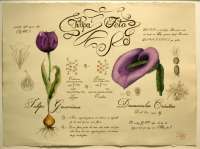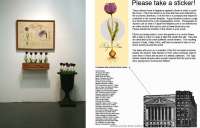Tulipa Feteo is a work that I hope will eventually result in a new breed of tulip. I have been searching for genetic biologists to collaborate with to cross the genetics of a carrion flower with those of a tulip to create a tulip that will smell like rotting flesh. Carrion flowers are pollinated by flies and produce animines putricine and cadavorine. The breaking down of these animines releases an odor that resembles rotting flesh or feces. Ideally, these new flowers will be covertly planted at sites involved in the current economic downturn. Currently this project exists as 17th Century style botanical renderings of the proposed genetic process that are accompanied by artificial tulips and stickers. The tulips and stickers are offered to viewers to take and place at economic sites of their choosing. A sign listing institutions that received TARP money suggests possible locations for proper sticker placement.
The tulips and stickers serve as a reminder of the first recorded economic bubble, the historic Tulip Bubble of 1637, when contracts for tulips sold for more than 10 times the income of a skilled craftsman. There are many similarities between the historic Tulip Bubble and the recent subprime mortgage bubble. Both bubbles were created by the belief that peak value would not be reached for some time. Like the Federal Reserve and the United States Government, the Dutch created policies that contributed to the rising price of tulips. A formal futures market was established in 1636 where tulips not yet existing could be sold though contracts to buy the bulbs at the end of the season. This was the same year tulips were added to the trade on the exchanges of many Dutch towns and cities. This led all members of society to participate in the tulip trade. Similarly, U.S. policies for home ownership though the National Housing Authority, reduced interest rates, and subprime mortgages resulted in an unprecedented level of home ownership in the United States. When the Tulip Bubble broke, the Dutch government allowed for the voiding of futures contracts, effectively protecting the investors and leaving many with worthless tulips. In the financial meltdown of 2008, the United States government also bailed out the investors leaving homeowners with negative equity.
There is a desire for economics to resemble science. Milton Freedman would commonly refer to economic law, comparing it to the laws of physics. Scholars such as Joseph Campbell have noted that scientific theorizing has become our contemporary modality of myth making. Tulipa Feteo exists on this border, where the study of economics is seen as a science and where science is considered a type of myth.
Tulipa Feteo is a work that I hope will eventually result in a new breed of tulip. I have been searching for genetic biologists to collaborate with to cross the genetics of a carrion flower with those of a tulip to create a tulip that will smell like rotting flesh. Carrion flowers are pollinated by flies and produce animines putricine and cadavorine. The breaking down of these animines releases an odor that resembles rotting flesh or feces. Ideally, these new flowers will be covertly planted at sites involved in the current economic downturn. Currently this project exists as 17th Century style botanical renderings of the proposed genetic process that are accompanied by artificial tulips and stickers. The tulips and stickers are offered to viewers to take and place at economic sites of their choosing. A sign listing institutions that received TARP money suggests possible locations for proper sticker placement.
The tulips and stickers serve as a reminder of the first recorded economic bubble, the historic Tulip Bubble of 1637, when contracts for tulips sold for more than 10 times the income of a skilled craftsman. There are many similarities between the historic Tulip Bubble and the recent subprime mortgage bubble. Both bubbles were created by the belief that peak value would not be reached for some time. Like the Federal Reserve and the United States Government, the Dutch created policies that contributed to the rising price of tulips. A formal futures market was established in 1636 where tulips not yet existing could be sold though contracts to buy the bulbs at the end of the season. This was the same year tulips were added to the trade on the exchanges of many Dutch towns and cities. This led all members of society to participate in the tulip trade. Similarly, U.S. policies for home ownership though the National Housing Authority, reduced interest rates, and subprime mortgages resulted in an unprecedented level of home ownership in the United States. When the Tulip Bubble broke, the Dutch government allowed for the voiding of futures contracts, effectively protecting the investors and leaving many with worthless tulips. In the financial meltdown of 2008, the United States government also bailed out the investors leaving homeowners with negative equity.
There is a desire for economics to resemble science. Milton Freedman would commonly refer to economic law, comparing it to the laws of physics. Scholars such as Joseph Campbell have noted that scientific theorizing has become our contemporary modality of myth making. Tulipa Feteo exists on this border, where the study of economics is seen as a science and where science is considered a type of myth.

